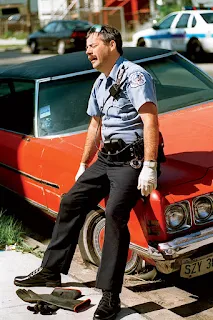The 1950s atomic monster movies expressed widespread anxieties about nuclear apocalypse that were otherwise suppressed by a combination of societal (and especially political) pressures, and psychological denial. So what are the buried fears that the persistently ongoing fashion for zombie stories might express?
I wrote about this in 2017 in terms of super rich individuals and corporations (bloodsucking vampire capitalists) versus the mass of everyone else—the economically and therefore societally vulnerable and insecure, sometimes called the precariat (the zombies.) The metaphor and the relationships work when considering the origin of the zombie figure in Haiti, with tales of plantation owners using magic to resurrect the newly dead and use them as slaves. Early Hollywood movies adapted this premise.
Today’s zombies are said to have their direct origin in George Romero’s 1968 film Night of the Living Dead, which itself has spawned a series of films, apparently still ongoing. Though in that first movie the “living dead” are not called zombies, this has become the contemporary definition for other films and television shows.
The socioeconomic interpretation still works, and the Romero films found other applicable metaphors, like zombie consumers in a shopping mall. But maybe there’s another newly relevant metaphor as well.
In the 50s and early 60s, psychologist (including those employed by the government to study the situation) were surprised by the apparent lack of societal reaction to the spectre of possibly world-destroying nuclear weapons. Some of the first suggestions of fears were embodied in the seemingly innocuous atomic monster movies.
The same might be said of the muted response to the possibly world-destroying effects of climate distortion. While political denial clearly benefits fossil fuel megacorporations and the politicians they own, it might also be a convenient cover for the personal, psychological denial we all must engage in, at least from time to time, in order to stay sane. But persistent, extreme and even organized denial may have particular toxicity.
There is a sense that denial itself can turn people into zombies, both of the Haitian kind (slaves to wealthy economic interests) and of the Romero kind: people who are in a sense already dead but still walking, still struggling to survive.
Now the weeks and months of intense heat experienced by so many this summer suggests a more physical resonance, an embodiment of climate distortion effects. Specifically, the zombie figure suggests the effects of relentless extreme heat on human beings. For relentless heat dulls the brain, saps vitality and will, until people begin to feel and even look like the living dead.
It could be that these physical effects of extreme heat have escaped the consciousness of recent generations, with the omnipresence of air conditioning. Prior generations understood it—it’s present as another character in several Tennessee Williams plays, as well as the courtrooms of To Kill A Mockingbird and Inherit the Wind. I suppose my generation was the last in the US to grow up without air conditioning in every business and public building and every automobile, as well as most homes. Except of course in poorer places, where the past lived on.
But even if the medical community is somewhat baffled about the effects of atmospheric heat on the human body, somewhere in the unconscious that knowledge is visceral. Too much of it for too long and you not only feel like a zombie, you begin thinking and acting like one.This zombie summer is unlikely to be the last, and so our fears for that future might be expressed in these figures of ghoulish entertainment.













